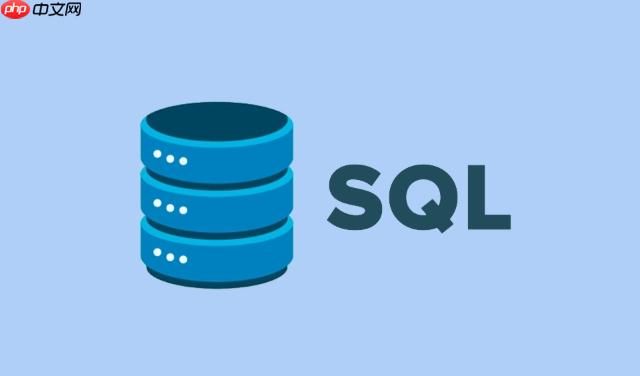SQLite内存数据库通过连接字符串"Data Source=:memory:;"在内存中创建,具有高速读写和部署便捷的优点,适用于单元测试、缓存、临时存储等场景;但数据易失,需通过BackupDatabase方法与磁盘文件结合实现持久化;并发访问受限,可通过WAL模式、短事务等优化,高并发场景可考虑其他数据库。

SQLite内存数据库数据源的创建,简单来说,就是在你的应用程序里开辟一块内存空间,让SQLite数据库直接在内存中运行,而不是像传统方式那样,把数据存储在硬盘上的文件中。这样做的好处是速度快,因为内存的读写速度远高于硬盘,而且部署方便,不需要额外的数据库服务器。
SQLite内存数据源配置教程:
创建内存数据库数据源的核心在于连接字符串的设置。你需要告诉SQLite驱动,你想连接的是一个内存数据库。
// C# 示例
using System.Data.SQLite;
// 连接字符串,":memory:" 指示SQLite创建一个内存数据库
string connectionString = "Data Source=:memory:;Version=3;";
using (SQLiteConnection connection = new SQLiteConnection(connectionString))
{
connection.Open();
// 在内存数据库中创建表
string createTableQuery = "CREATE TABLE IF NOT EXISTS MyTable (Id INTEGER PRIMARY KEY, Name TEXT);";
using (SQLiteCommand command = new SQLiteCommand(createTableQuery, connection))
{
command.ExecuteNonQuery();
}
// 插入数据
string insertQuery = "INSERT INTO MyTable (Name) VALUES ('Example Data');";
using (SQLiteCommand command = new SQLiteCommand(insertQuery, connection))
{
command.ExecuteNonQuery();
}
// 查询数据
string selectQuery = "SELECT * FROM MyTable;";
using (SQLiteCommand command = new SQLiteCommand(selectQuery, connection))
{
using (SQLiteDataReader reader = command.ExecuteReader())
{
while (reader.Read())
{
Console.WriteLine($"Id: {reader["Id"]}, Name: {reader["Name"]}");
}
}
}
connection.Close();
}这段代码展示了如何在C#中创建一个SQLite内存数据库,创建表,插入数据,并查询数据。关键在于
Data Source=:memory:;Version=3;
内存数据库数据丢失问题如何解决?
内存数据库的最大缺点是数据易失性。一旦程序关闭,内存中的数据就会丢失。所以,如果需要在程序的不同会话之间保持数据,或者需要备份数据,你需要考虑将内存数据库的内容保存到磁盘文件。
一个常见的做法是在程序启动时,从磁盘文件加载数据到内存数据库,程序关闭时,将内存数据库的数据保存回磁盘文件。
// C# 示例
// 从文件加载数据到内存数据库
public static void LoadDataFromFile(string dbFilePath, SQLiteConnection memoryConnection)
{
using (SQLiteConnection fileConnection = new SQLiteConnection($"Data Source={dbFilePath};Version=3;"))
{
fileConnection.Open();
fileConnection.BackupDatabase(memoryConnection, "main", "main", -1, null, 0);
fileConnection.Close();
}
}
// 将内存数据库保存到文件
public static void SaveDataToFile(string dbFilePath, SQLiteConnection memoryConnection)
{
using (SQLiteConnection fileConnection = new SQLiteConnection($"Data Source={dbFilePath};Version=3;"))
{
fileConnection.Open();
memoryConnection.BackupDatabase(fileConnection, "main", "main", -1, null, 0);
fileConnection.Close();
}
}
// 使用示例
string dbFilePath = "mydatabase.db";
string memoryConnectionString = "Data Source=:memory:;Version=3;";
using (SQLiteConnection memoryConnection = new SQLiteConnection(memoryConnectionString))
{
memoryConnection.Open();
// 从文件加载数据
if (File.Exists(dbFilePath))
{
LoadDataFromFile(dbFilePath, memoryConnection);
}
else
{
// 如果文件不存在,则创建表
string createTableQuery = "CREATE TABLE IF NOT EXISTS MyTable (Id INTEGER PRIMARY KEY, Name TEXT);";
using (SQLiteCommand command = new SQLiteCommand(createTableQuery, memoryConnection))
{
command.ExecuteNonQuery();
}
}
// ... 执行数据库操作 ...
// 保存数据到文件
SaveDataToFile(dbFilePath, memoryConnection);
memoryConnection.Close();
}这段代码展示了如何将SQLite内存数据库与磁盘文件结合使用,以解决数据持久化的问题。
BackupDatabase
SQLite内存数据库的并发访问问题?
SQLite本身对并发访问有一定的限制。虽然它支持多线程访问,但在高并发场景下,可能会出现锁冲突,影响性能。
对于内存数据库,由于所有操作都在同一进程的内存中进行,锁的竞争可能会更加激烈。
为了解决这个问题,可以考虑以下策略:
在选择并发策略时,需要根据具体的应用场景和性能需求进行权衡。
SQLite内存数据库的适用场景?
内存数据库非常适合以下场景:
总之,SQLite内存数据库是一个非常有用的工具,但在使用时需要充分了解其优缺点,并根据具体的应用场景进行选择。
以上就是SQLite内存数据库数据源创建_SQLite内存数据源配置教程的详细内容,更多请关注php中文网其它相关文章!

每个人都需要一台速度更快、更稳定的 PC。随着时间的推移,垃圾文件、旧注册表数据和不必要的后台进程会占用资源并降低性能。幸运的是,许多工具可以让 Windows 保持平稳运行。

Copyright 2014-2025 https://www.php.cn/ All Rights Reserved | php.cn | 湘ICP备2023035733号